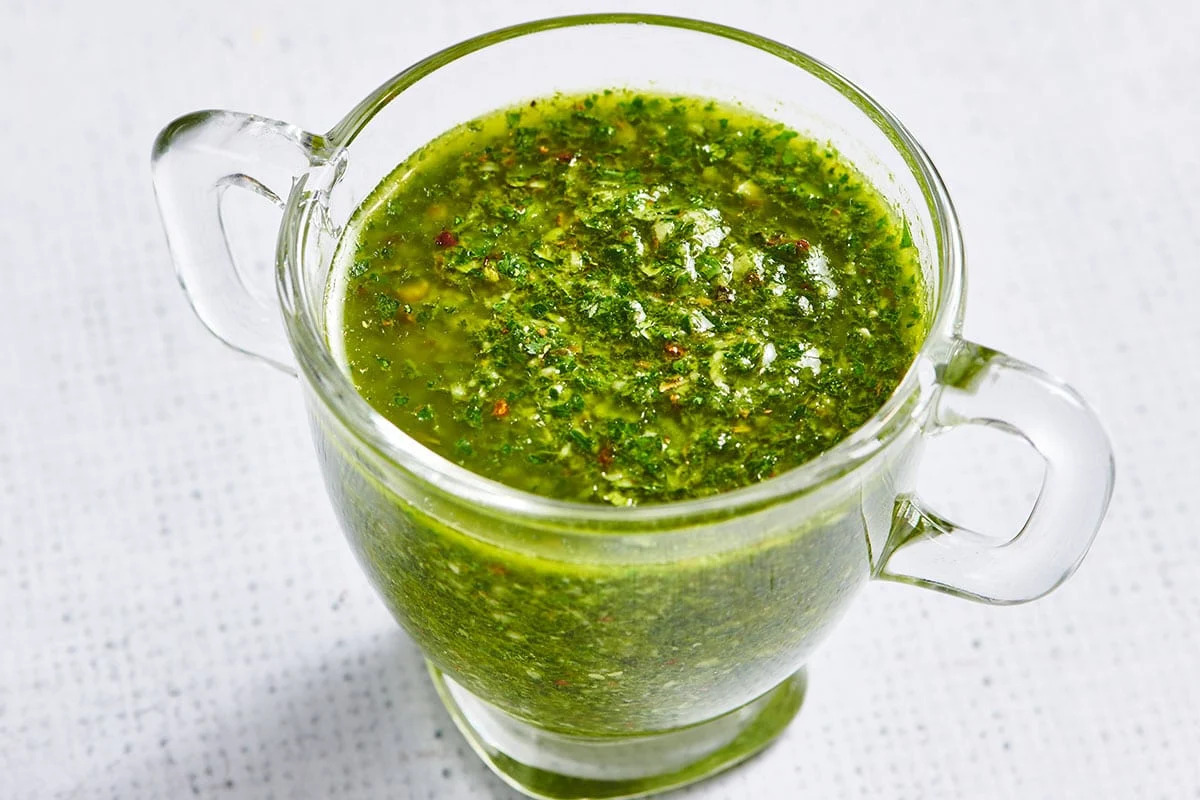Chimichurri is a vibrant and tangy sauce that hails from Argentina, known for its ability to elevate grilled meats to new heights. This herbaceous concoction is a staple in South American cuisine, offering a delightful blend of fresh parsley, garlic, and olive oil. Whether drizzled over a perfectly cooked steak or used as a marinade, chimichurri brings a burst of flavor that is both refreshing and bold. Its simplicity and versatility make it a must-have in any culinary repertoire.
When preparing to make chimichurri, you might find that fresh parsley and red wine vinegar are not always staples in every kitchen. Fresh parsley is essential for the bright, herbal flavor that defines this sauce, so be sure to pick up a bunch at the supermarket. Red wine vinegar adds a necessary tanginess, and while it might not be as common as other vinegars, it is crucial for achieving the authentic taste of chimichurri.

Ingredients For Chimichurri Recipe
Parsley: Fresh parsley is the star of chimichurri, providing a bright, herbal flavor that forms the base of the sauce.
Olive oil: Olive oil acts as the rich, smooth carrier for the other ingredients, ensuring a cohesive blend.
Red wine vinegar: This vinegar adds a tangy depth to the sauce, balancing the richness of the olive oil.
Garlic: Minced garlic infuses the chimichurri with a pungent, savory aroma and taste.
Oregano: Dried oregano contributes an earthy, slightly bitter note that complements the fresh herbs.
Red pepper flakes: These flakes add a subtle heat, giving the sauce a gentle kick.
Salt: Salt enhances all the flavors, bringing out the best in each ingredient.
Black pepper: Black pepper adds a mild spiciness and depth to the overall flavor profile.
Technique Tip for This Recipe
To enhance the flavor of your chimichurri, allow it to sit for at least 30 minutes before serving. This resting time lets the parsley, garlic, and oregano meld together with the olive oil and red wine vinegar, creating a more harmonious and robust taste. If you have the time, refrigerate it overnight for an even deeper infusion of flavors.
Suggested Side Dishes
Alternative Ingredients
fresh parsley - Substitute with cilantro: Cilantro provides a fresh and vibrant flavor similar to parsley, though it will add a slightly different aromatic profile.
olive oil - Substitute with grapeseed oil: Grapeseed oil has a mild flavor and a similar texture, making it a good alternative for olive oil in dressings and marinades.
red wine vinegar - Substitute with apple cider vinegar: Apple cider vinegar offers a tangy flavor that can mimic the acidity of red wine vinegar, though it may add a slightly sweeter note.
minced garlic - Substitute with garlic powder: Garlic powder can be used in place of fresh garlic, though it will lack the fresh pungency and texture. Use about ⅛ teaspoon of garlic powder per clove.
dried oregano - Substitute with dried thyme: Dried thyme can provide a similar earthy and slightly minty flavor, though it is less pungent than oregano.
red pepper flakes - Substitute with cayenne pepper: Cayenne pepper can add a similar heat level, but use it sparingly as it is more potent than red pepper flakes.
salt - Substitute with soy sauce: Soy sauce can add a salty and umami flavor, though it will also introduce a different taste profile and color.
black pepper - Substitute with white pepper: White pepper can provide a similar heat and flavor, though it is slightly milder and less aromatic.
Alternative Recipes Similar to This
How to Store or Freeze This Dish
To keep your chimichurri fresh and vibrant, store it in an airtight container. A glass jar with a tight-fitting lid works wonders, preserving the flavors and preventing any unwanted odors from sneaking in.
Before sealing the container, pour a thin layer of olive oil over the top of the chimichurri. This acts as a protective barrier, keeping the herbs from oxidizing and maintaining that beautiful green hue.
Place the container in the refrigerator. Your chimichurri will stay fresh for up to a week, ready to elevate any dish with its zesty charm.
If you find yourself with an abundance of chimichurri, fear not! Freezing is a fantastic option. Pour the sauce into an ice cube tray, filling each compartment about three-quarters full.
Once frozen solid, transfer the chimichurri cubes to a resealable plastic bag or a freezer-safe container. This method allows you to grab just the right amount whenever you need a burst of flavor.
When you're ready to use your frozen chimichurri, simply pop out a cube or two and let them thaw in the refrigerator or at room temperature. The sauce may separate slightly upon thawing, but a quick stir will bring it back to life.
For an extra touch of culinary magic, try adding a cube of frozen chimichurri to a hot pan. As it melts, it will infuse your meat, vegetables, or soups with its aromatic goodness, creating a symphony of flavors that dance on your palate.
How to Reheat Leftovers
Gently warm the chimichurri by placing it in a small saucepan over low heat. Stir occasionally to ensure even heating, but be cautious not to overheat as this can dull the vibrant flavors of the fresh parsley and red wine vinegar.
If you prefer a quicker method, microwave the chimichurri in a microwave-safe bowl. Use a low power setting and heat in short intervals of 10-15 seconds, stirring in between to maintain its consistency and flavor.
For a more rustic approach, place the chimichurri in a heatproof bowl and set it over a pot of simmering water, creating a gentle double boiler effect. This method allows the sauce to warm gradually, preserving the aromatic qualities of the minced garlic and dried oregano.
If you're using the chimichurri as a topping for grilled meat, consider brushing it onto the meat during the last few minutes of cooking. This not only warms the sauce but also infuses the meat with its zesty essence.
Essential Tools for This Recipe
Blender: A kitchen appliance used to mix, purée, or emulsify food and other substances. It's perfect for blending the chimichurri ingredients into a smooth sauce.
Food processor: An alternative to a blender, this tool is used for chopping, slicing, and blending ingredients. It can be used to achieve a slightly chunkier texture if preferred.
Measuring cups: Essential for accurately measuring the parsley, olive oil, and red wine vinegar to ensure the right balance of flavors.
Measuring spoons: Used for measuring smaller quantities of ingredients like oregano, red pepper flakes, salt, and black pepper.
Knife: A sharp tool necessary for finely chopping the fresh parsley and mincing the garlic cloves.
Cutting board: A sturdy surface to safely chop the parsley and garlic.
Mixing bowl: If you prefer to mix the ingredients by hand before blending, a mixing bowl can be used to combine everything.
Spatula: Useful for scraping down the sides of the blender or food processor to ensure all ingredients are well incorporated.
Storage container: If not serving immediately, a container with a lid is needed to store the chimichurri in the refrigerator.

Chimichurri Recipe
Ingredients
Main Ingredients
- 1 cup Fresh parsley finely chopped
- ½ cup Olive oil
- ¼ cup Red wine vinegar
- 4 cloves Garlic minced
- 1 teaspoon Dried oregano
- ½ teaspoon Red pepper flakes
- 1 teaspoon Salt
- ½ teaspoon Black pepper
Instructions
- 1. Combine all ingredients in a blender or food processor.
- 2. Blend until smooth.
- 3. Adjust seasoning to taste.
- 4. Serve immediately or refrigerate for later use.
Nutritional Value
Keywords
More Amazing Recipes to Try 🙂
- Cold Greek Tortellini Salad Recipe25 Minutes
- Baked Oatmeal Breakfast Bars Recipe40 Minutes
- Caldo Verde Portuguese Green Soup Recipe45 Minutes
- Manhattan Recipe5 Minutes
- Spinach and Ricotta Puff Pastry Recipe40 Minutes
- Gluten-Free Fried Cheese Curds Recipe20 Minutes
- Slow Cooker Beef Stroganoff Recipe8 Hours 15 Minutes
- Garlic Shrimp Pasta30 Minutes


Leave a Reply